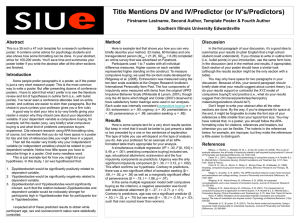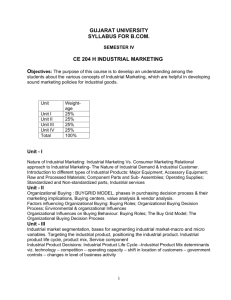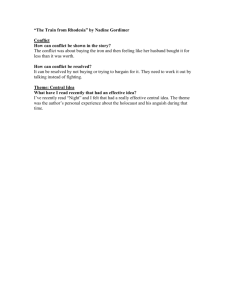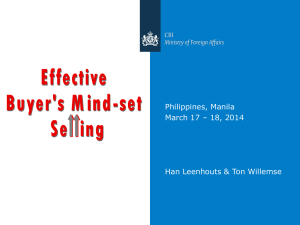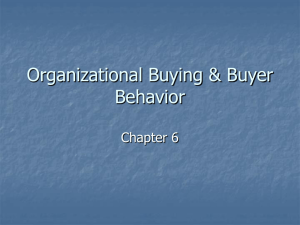SPECIAL SESSION SUMMARY
advertisement
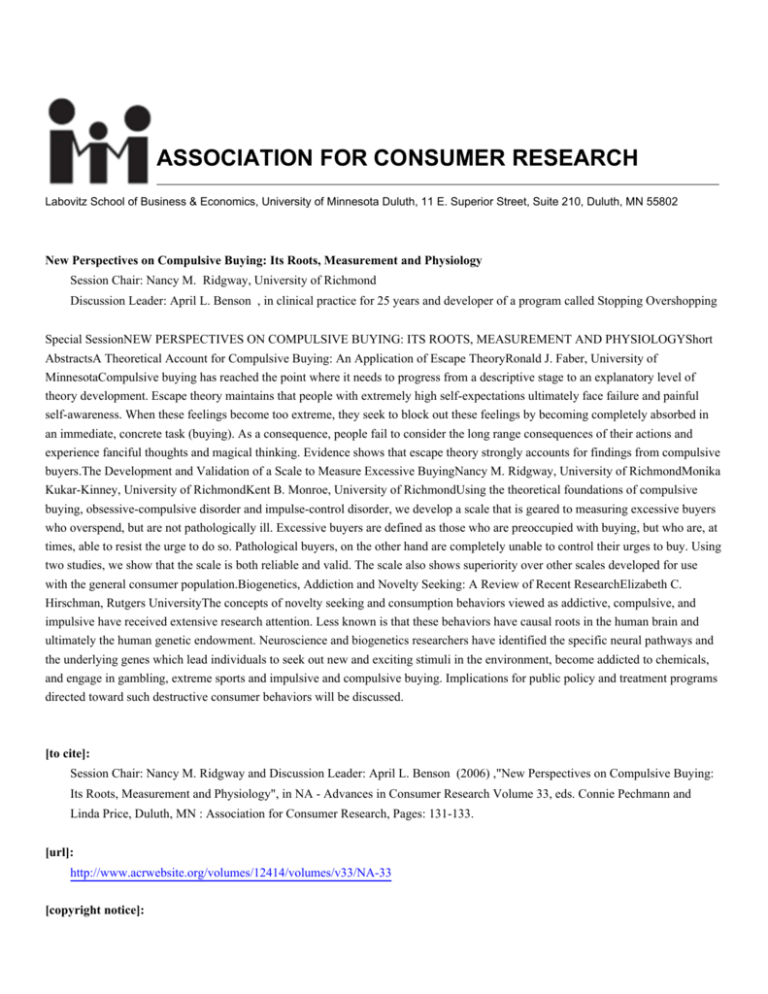
ASSOCIATION FOR CONSUMER RESEARCH
Labovitz School of Business & Economics, University of Minnesota Duluth, 11 E. Superior Street, Suite 210, Duluth, MN 55802
New Perspectives on Compulsive Buying: Its Roots, Measurement and Physiology
Session Chair: Nancy M. Ridgway, University of Richmond
Discussion Leader: April L. Benson , in clinical practice for 25 years and developer of a program called Stopping Overshopping
Special SessionNEW PERSPECTIVES ON COMPULSIVE BUYING: ITS ROOTS, MEASUREMENT AND PHYSIOLOGYShort
AbstractsA Theoretical Account for Compulsive Buying: An Application of Escape TheoryRonald J. Faber, University of
MinnesotaCompulsive buying has reached the point where it needs to progress from a descriptive stage to an explanatory level of
theory development. Escape theory maintains that people with extremely high self-expectations ultimately face failure and painful
self-awareness. When these feelings become too extreme, they seek to block out these feelings by becoming completely absorbed in
an immediate, concrete task (buying). As a consequence, people fail to consider the long range consequences of their actions and
experience fanciful thoughts and magical thinking. Evidence shows that escape theory strongly accounts for findings from compulsive
buyers.The Development and Validation of a Scale to Measure Excessive BuyingNancy M. Ridgway, University of RichmondMonika
Kukar-Kinney, University of RichmondKent B. Monroe, University of RichmondUsing the theoretical foundations of compulsive
buying, obsessive-compulsive disorder and impulse-control disorder, we develop a scale that is geared to measuring excessive buyers
who overspend, but are not pathologically ill. Excessive buyers are defined as those who are preoccupied with buying, but who are, at
times, able to resist the urge to do so. Pathological buyers, on the other hand are completely unable to control their urges to buy. Using
two studies, we show that the scale is both reliable and valid. The scale also shows superiority over other scales developed for use
with the general consumer population.Biogenetics, Addiction and Novelty Seeking: A Review of Recent ResearchElizabeth C.
Hirschman, Rutgers UniversityThe concepts of novelty seeking and consumption behaviors viewed as addictive, compulsive, and
impulsive have received extensive research attention. Less known is that these behaviors have causal roots in the human brain and
ultimately the human genetic endowment. Neuroscience and biogenetics researchers have identified the specific neural pathways and
the underlying genes which lead individuals to seek out new and exciting stimuli in the environment, become addicted to chemicals,
and engage in gambling, extreme sports and impulsive and compulsive buying. Implications for public policy and treatment programs
directed toward such destructive consumer behaviors will be discussed.
[to cite]:
Session Chair: Nancy M. Ridgway and Discussion Leader: April L. Benson (2006) ,"New Perspectives on Compulsive Buying:
Its Roots, Measurement and Physiology", in NA - Advances in Consumer Research Volume 33, eds. Connie Pechmann and
Linda Price, Duluth, MN : Association for Consumer Research, Pages: 131-133.
[url]:
http://www.acrwebsite.org/volumes/12414/volumes/v33/NA-33
[copyright notice]:
This work is copyrighted by The Association for Consumer Research. For permission to copy or use this work in whole or in
part, please contact the Copyright Clearance Center at http://www.copyright.com/.
SPECIAL SESSION SUMMARY
New Perspectives on Compulsive Buying: Its Roots, Measurement and Physiology
Nancy M. Ridgway, University of Richmond
Monika Kukar-Kinney, University of Richmond
Kent B. Monroe, University of Richmond
SESSION OVERVIEW
EXTENDED ABSTRACTS
Compulsive buying and other dysfunctional consumption
behaviors have attracted substantial attention of consumer and
other researchers in recent years. However, most research to date
remains descriptive, and many theoretical, substantive and methodological issues remain unresolved.
The first paper provides a theoretical framework, specifically
escape theory, to explain why people engage in a self-destructive
behavior, such as compulsive buying. Escape theory maintains that
for some people, self-awareness can be very painful. Usually, these
people have self-expectations that are so high they are unable to
fulfill them. To block-out the painful self-awareness, these people
become totally absorbed in a task, such as buying, without considering long-range consequences. The paper suggests that compulsive buying can be explained as a manifestation of escape theory.
Using the theoretical foundations of compulsive buying, obsessive-compulsive disorder and impulse-control disorder, the second paper addresses a development of a scale that is geared toward
measuring excessive buying of those consumers who overspend,
but are not pathologically ill. Excessive buyers are defined as those
who are preoccupied with buying, but who are, at times, able to
resist the urge to do so. Pathological buyers, on the other hand are
completely unable to control their urges to buy. Using two studies,
the authors show the scale is both reliable and valid. Moreover, by
developing a scale to measure excessive buying as a construct
containing elements of both obsessive-compulsive and impulsecontrol disorders, an important methodological contribution is
made to the literature.
The final paper takes a broader look at dysfunctional/destructive consumption behaviors in general, of which compulsive buying is one example. The author provides a biogenetics perspective
to explain why consumers engage in compulsive/addictive/impulsive and novelty seeking behaviors. Specific portions of human
brain, and ultimately the human genetic endowment appear to be
responsible for the tendency towards such behaviors. The paper
further discusses implications for public policy and treatment
programs.
While the first two papers provide new theoretical and methodological perspectives on compulsive and excessive buying behavior specifically, the third paper places compulsive buying in a
larger setting of other destructive consumption behaviors and
provides a biogenetics explanation for why such behaviors occur.
As a set, the three papers importantly advance knowledge on what
compulsive buying is, what its causal roots are, and how to measure
it. While compulsive buying and other dysfunctional consumption
behaviors are important consumer behaviors, they have been investigated predominantly in the psychological and psychiatric journals, and only sporadically in the consumer research literature.
Dr. April Lane Benson (author of the widely acclaimed book
I Shop, Therefore I am: Compulsive Buying and the Search for Self;
in clinical practice for 25 years and developer of a program called
Stopping Overshopping) served as a discussant of the session and
offered the perspective of a clinician who has worked extensively
with patients whose lives are negatively affected by compulsive
buying disorder.
“A Theoretical Account for Compulsive Buying: An
Application of Escape Theory”
Ronald J. Faber
The past 20 years has witnessed a huge growth in research on
compulsive buying. However, most of this research has remained
at a descriptive stage identifying variables that are related to
compulsive buying, patterns of behavior, and related disorders.
Factors linked to compulsive buying have included: 1) psychological factors such as low self esteem, depression, anxiety, and
perfectionism; 2) biological ones reflected in the impact of drug
therapies and neurotransmission, linkages to arousal, and personal
and family histories of compulsive buying and related disorders;
and 3) cultural ones such as gender roles, early childhood experiences and changing social norms and feeling of alienation.
One explanation for compulsive buying is that it serves as a
form of mood manipulation for people who experience negative
feelings (Faber and Christenson 1996). Research in psychology,
communication and consumer behavior has found that people will
engage in specific behaviors as a means to change undesirable
mood states or to prolong more desirable ones. Studies of compulsive buyers have found that they are particularly prone to engage in
this behavior when they are in negative mood states and their
description of episodes of compulsive buying suggests that they
experience these episodes in positive and arousing terms. Additionally, the compulsive buyers were far more likely to report that their
mood states moved in a positive direction as a result of shopping
than did the matched general consumers. Thus, compulsive buyers
may engage in buying as a way to manage their mood states.
Jacobs (1989) proposed that there are two important components that make people susceptible to addictive or excessive behaviors. One is their ability to alter negative affective states and the
second is their ability to change physiological arousal levels. He
suggests that some people have a physiological resting state that
they find aversive. To overcome this, they seek behaviors that can
heighten or reduce their arousal level and they run the risk of
becoming addicted to such activities or substances.
While both of these accounts for compulsive buying suggest
what benefits the behavior may provide, they don’t fully address the
fact that compulsive buying, by definition, leads to extreme negative consequences. For example, compulsive buying has been
referred to as causing “excessive and inappropriate impairment in
one or more life domains” (Black 2000), and marked distress that
“interferes with social or occupational functioning” (Goldsmith
and McElroy 2000). However, the literature on self-defeating
behaviors has suggested that people are not prone to harming
themselves (Baumeister and Scher 1988). Instead, such behaviors
result from poor strategy choices that don’t work as intended, or
from a conscious decision to engage in a negative behavior to avoid
even more painful loses. This latter explanation has led to escape
theory, which has been used to explain behaviors such as eating
disorders and suicide. It is proposed here that escape theory may
also provide the best theoretical account for why compulsive buyers
engage in this destructive behavior.
131
Advances in Consumer Research
Volume 33, © 2006
132 / New Perspectives on Compulsive Buying: Its Roots, Measurement and Physiology
Escape theory maintains that for some people, self-awareness
can be very painful. Typically, these people have exceptionally
high standards or expectations that they are unable to meet, leading
to a sense of failure, low self-esteem, anxiety and depression. When
these feelings become too extreme, they seek ways to block out this
painful self-awareness, at least for a little while. The way people
accomplish this is by becoming completely absorbed in an immediate, concrete, low-level task. By focusing on this activity and the
sights, sounds and other sensations within this limited environment,
they are able to block out the painful sense of self. Two additional
consequences of the cognitive narrowing is that during this period:
1) consideration of long range consequences of an action are not
considered; and 2) the implausibility of fanciful thoughts is not
recognized, giving way to non-critical and irrational beliefs and
magical thinking.
This paper shows how each of these characteristics of escape
theory is present in accounts of compulsive buying. It shows that:
1) compulsive buyers experience negative and painful self-awareness; 2) compulsive buyers tend to be perfectionist and hold
themselves to impossibly high standards; 3) perceived failure and
negative self feelings trigger compulsive buying episodes; 4) a high
level of absorption and cognitive narrowing characterize these
episodes; 5) during these episodes, compulsive buyers engage in
fanciful and magical thinking; and 6) compulsive buyers block out
long range consequences when engaged in compulsive buying.
Thus, it is suggested that compulsive buying can best be explained
as a manifestation of escape theory.
“The Development and Validation of a Scale to Measure
Excessive Buying”
Nancy M. Ridgway, Monika Kukar-Kinney, Kent B. Monroe
In recent years, hundreds of popular press articles, books, and
websites have been devoted to the problems experienced by compulsive buyers (e.g., Adams 2003; Benson 2000; Chaker 2003;
Ethridge 2002, etc.). Researchers traditionally have used the term
“compulsive buying” to describe the dysfunctional, maladaptive,
or abnormal consumptive behaviors exhibited by a small number of
pathologically ill consumers who are unable to control the overpowering impulse or urge to buy.
While a relatively small percentage of the general population
may qualify as pathological compulsive buyers, in that they cannot
resist the urge to buy and that their buying behavior results in
unmanageable financial debt, it is our belief that more consumers
are affected by what we term “excessive buying”. In comparison
with pathological compulsive buyers, excessive buyers may not
continuously experience an uncontrollable urge to buy. However,
they may occasionally or often exhibit tendencies for buying too
much and too frequently. A second key difference between excessive and compulsive buying is that it is not necessary that excessive
spending results in harm (particularly financial) to the consumer
(Faber and O’Guinn 1992; Hassay and Smith 1996). In many
respects, excessive buying is similar to compulsive buying; however, it covers a broader set of consumers. Indeed, the popular press
articles alluded to above seem to be more about excessive buying
than the pathology of compulsive buying (Chaker 2003; Hoffman
2000; Kelly 1999).
Using the theoretical foundations of compulsive buying, obsessive-compulsive disorder, impulse-control disorder and obsessive-compulsive spectrum disorder, we developed a scale to measure excessive buying. To develop and validate the scale, two
studies were conducted. The first study, using 352 undergraduate
students as a sample, was used to narrow down the potential set of
scale items to the final twelve by conducting first exploratory,
followed by confirmatory factor analysis. The final scale consists of
four dimensions/factors (obsessive-compulsive preoccupation with
buying; impulse-control buying; positive feelings associated with
buying; negative feelings leading to buying). Each dimension is
measured with three items.
The second study, in which a sample of 555 university staff
members participated, was conducted to validate the scale. This
sample was more heterogeneous in terms of age and education, and
less heterogeneous in terms of gender (93 percent women); and,
hence, more relevant to the study of excessive and compulsive
buying behavior, which has previously been found to plague
women more than men (e.g., Black 2001; d’Astous 1990).
Confirmatory factor analysis results show that the four factor
model with underlying second-order factor fits the data well (the
best in comparison with other alternative models). The scale is also
reliable (?=.91 and .90 in studies 1 and 2, respectively). Discriminant and nomological validity were evaluated by correlating the
excessive buying scale with other constructs, for example obsessive-compulsive disorder (to evaluate discriminant validity), materialism, self-esteem, stress, frequency of returning items and hiding
behavior. The scale correlates with all these constructs in the
theoretically-predicted manner, thus displaying nomological validity. Moreover, non-response and response biases were also evaluated. Finally, directions for future research on excessive buying
were discussed.
“Biogenetics, Addiction and Novelty Seeking: A Review of
Recent Research”
Elizabeth C. Hirschman
Both addictive/compulsive behaviors and novelty/stimulation-seeking behaviors have been subjected to scrutiny by consumer researchers over the past three decades (Faber, Christensen,
de Zwaan and Mitchell 1995, Hirschman 1981, 1992, O’Guinn and
Faber 1989, Raju 1980, Rook 1987, Rook and Fisher 1995). A
review of the biogenetics literature from the 1990’s found significant linkages between neurological features, such as genetic mutations and dopaminergic signaling and these two consumption
behaviors. Indeed the empirical findings suggest that addictive/
compulsive tendencies and novelty seeking are closely related at
the biogenetic level (Hirschman and Stern 2001).
The present paper extends this line of inquiry by reviewing the
biogenetics literature pertaining to addiction and novelty seeking
over the past five years (i.e., 2000-2005). Previous work showed
that two genetic mutations in the dopamine receptor alleles DRD4
and DRD2 were identified. These mutations caused fewer than
normal receptor sites to be present in the brain. To compensate, the
consumer possessing these mutations may engage in novelty seeking, self-medication, be more likely to suffer from ADHD, have
eating disorders and heightened impulsivity. Several new and
highly significant findings have emerged which describe in detail
the neuronal reward pathways characterizing both addictive and
novelty seeking tendencies. Perhaps most profoundly, these have
now been traced back to at least one evolutionary genetic mutation
which was likely central to several positive expressions of human
innovativeness, for example the development of agriculture and
migratory/exploratory tendencies leading to the discovery of new
continents and the spread of the human species.
As a result of more advanced brain imaging technologies and
more detailed genetic coding studies, several significant advances
have been made. Comings and Blum (2000) note that the two
critical areas for understanding both addictive and stimulation
seeking behaviors lie in the dopaminergic and opiodergic pathways
of the brain “both of which are critical for {human} survival, since
they provide the pleasure drives for eating, love, and reproduction”
(“Reward Deficiency Syndrome”). In their view, the genetic muta-
Advances in Consumer Research (Volume 33) / 133
tions which lead to above average levels of reward-seeking (the
reward deficiency syndrome), constitute behavioral disorders due
to their linkage to self-destructive consumption activities, such as
gambling, compulsive purchasing and alcoholism.
By 2002, research had implicated a specific polymorphism
within the mu-opioid receptor gene (the G variant of the +118A
allele) as a precursor to generalized substance abuse (Schinka et al.
2002). In fact, 95% of the study’s participants who were multiple
substance abusers carried this genetic mutation. Experientially,
persons carrying this version of the gene will have enhanced
feelings of pleasure, stimulation and euphoria when consuming
substances, such as alcohol, nicotine, heroin and cocaine, which are
the result of higher blood levels of beta endorphin and higher
stimulation of neural dopamine receptors. This creates a learned
response of reinforcement and motivation to seek out additional
stimulation.
This stimulation seeking behavior appears linked, as well, to
genetic preferences for sweet tastes and novelty seeking, as measured by Cloninger’s TPQ Novelty Seeking scale, according to
Kompov-Polevoy et al. (2004). Research (Johanssen and Hansen
2001) also demonstrated that Cloninger’s TPQ trait of lower-thanaverage Harm Avoidance, often found to characterize persons
engaging in extreme sports, was also linked to Type 2 alcoholism.
Schultz (2001) offers an alternative paradigm for viewing
these same characteristics: “{dopamine} systems appear to be
crucially involved in the use of reward information for learning and
maintaining approach and consummatory behavior (p. 293)….”
Rewards are events or objects that make subjects “come back for
more” and have three basic functions—they elicit approach and
consummatory behavior and serve as goals of voluntary behavior,
they have positive reinforcing effects, and they induce subjective
feelings of pleasure (hedonia) and positive emotional states (p.
293)”.
In other words, persons with higher than average rewardseeking behavior, which may lead to dysfunctional consequences,
such as addiction, compulsive purchasing, and inattention in school
(ADHD) due to genetic characteristics, represent an ‘extreme’ or
‘enhanced’ version of normal, human behavior. They are not
radically different than most people, they just want more than most
people—more stimulation, more excitement, more novelty, more
pleasure, more activity and so forth. Sometimes their quest for more
will bring positive results to themselves and others; sometimes the
results will be negative.
Ding et al. (2001) brings us back to the DRD4 dopamine
receptor 7-repeat allele, one of the first mutations linked to compulsive shopping and other impulse-control disorders. Using advanced
SNP DNA haplotype testing, these researchers learned that this
receptor is an ancient mutation and speaks to the idea that having
humans from those with and without this mutation make for a more
balanced society. These theories were tied to the DRD4-7-repeat
mutation and both the positive and negative impacts it has on human
existence.


